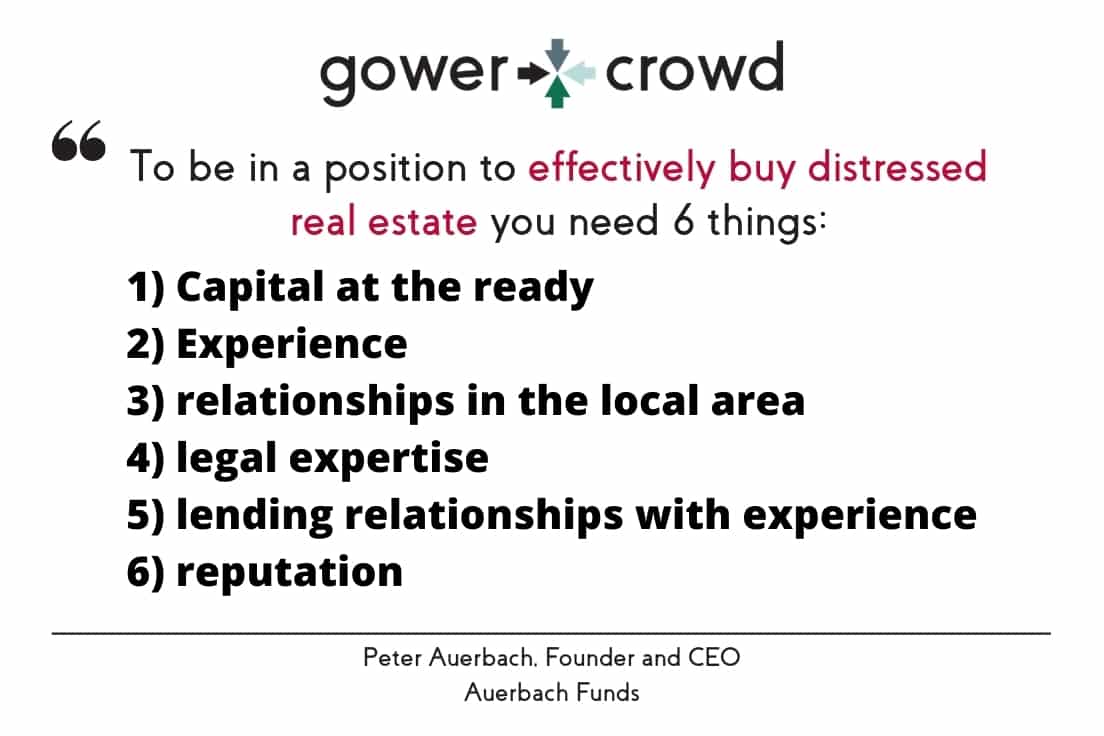WHITE BOARD WORKSHOP
Need More Money to Finance Your Real Estate Projects?
Learn how to find more investors, raise more money, and finance your real estate projects online.
How to Buy Distressed Real Estate
Whether you’re a first-time or seasoned investor, you’ve probably heard your peers discuss some of the great deals they’ve made by investing in distressed real estate. In commercial real estate, distressed property can take many forms. People typically think distressed real estate is a result of a building’s deteriorating physical condition, but distressed property can be a result of other factors, as well, such as incorrect pricing, mismanagement or, most often, a flaw in the capital stack brought about by too much debt.
Learn more about distressed real estate in The Real Estate Reality Show on YouTube.
In this article, we’ll look at how to buy distressed real estate. Distressed opportunities are particularly interesting in today’s environment given the challenges the market has faced in the wake of COVID-19. Read on for more.
What is the Definition of Distressed Real Estate?
Distressed real estate, often referred to as “opportunistic” real estate, is property that is sold at a discount due to one of five specific conditions: deteriorating physical condition, incorrect pricing, mismanagement, a short-term environmental problem or excessive debt causing the property to become vulnerable to foreclosure. It is important to note that distressed situations can arise because of property-specific issues, OR owner-specific issues, as described below.
-
Deteriorating physical condition:
- When most people think of distressed real estate, they think of a building in deteriorating physical condition. These distressed situations are often caused by a lack of routine maintenance or deferred capital improvements. For example, an owner may have allowed a small roof repair to linger and, over time, that roof deteriorates to the point of collapsing, creating a much more expensive problem that needs to be fixed that the owner cannot afford. In the meantime, tenants have to move out of the building, which disrupts the cash flow. As a result, the owner cannot afford the mortgage or the necessary improvements, and therefore, sells as a distressed asset.
-
Incorrect pricing:
- Incorrect pricing refers to a situation in which the owner has overvalued their property, and as a result, the property fails to attract attention from investors. This often happens when a long-time owner tries to sell the property on his or her own, without the support of a broker who would otherwise help price the property appropriately. In situations like these, the owner may begin to defer property improvements until sale—but absent a sale, the property begins to deteriorate (see above). This presents an opportunity for a buyer to present a creative solution to the seller. For example, instead of paying the owner’s asking price (which is valued too high), a developer may suggest they engage in a joint venture in which the owner contributes the land and the sponsor redevelops the site for a higher an better use, thereby providing the owner with a higher-value exit strategy or increased cash flow over the longer-term.
- Incorrect pricing refers to a situation in which the owner has overvalued their property, and as a result, the property fails to attract attention from investors. This often happens when a long-time owner tries to sell the property on his or her own, without the support of a broker who would otherwise help price the property appropriately. In situations like these, the owner may begin to defer property improvements until sale—but absent a sale, the property begins to deteriorate (see above). This presents an opportunity for a buyer to present a creative solution to the seller. For example, instead of paying the owner’s asking price (which is valued too high), a developer may suggest they engage in a joint venture in which the owner contributes the land and the sponsor redevelops the site for a higher an better use, thereby providing the owner with a higher-value exit strategy or increased cash flow over the longer-term.
-
Mismanagement:
- Mismanagement can take many forms. Most people tend to think of mismanagement as a failure to maintain the property, but it can also be mismanagement of operations. For example, an absentee landlord might fail to stay abreast of local market conditions and as a result, does not increase rents appropriately over time. This makes the property seem of lower value, at least on paper. Or maybe the owner struggles to fill vacancies, which would be easy to fill with modest property improvements. This creates a tremendous opportunity for value-add investors looking to turn a distressed property into a cash flowing asset.
- Mismanagement can take many forms. Most people tend to think of mismanagement as a failure to maintain the property, but it can also be mismanagement of operations. For example, an absentee landlord might fail to stay abreast of local market conditions and as a result, does not increase rents appropriately over time. This makes the property seem of lower value, at least on paper. Or maybe the owner struggles to fill vacancies, which would be easy to fill with modest property improvements. This creates a tremendous opportunity for value-add investors looking to turn a distressed property into a cash flowing asset.
-
Short-term environmental problem:
- Some distressed situations come as a result of a short-term environmental problem, such as the COVID-19 crisis. Many hotel and retail investors find themselves in this situation right now. For example, a hotel investor may need a liquidity injection and as such, may sell an asset at a reduced price to a group with reliable capital in order to produce the quick exit he needs to stabilize the rest of his portfolio. It may be that the property otherwise would perform well, but in the current environment (e.g., a lack of travel as a result of COVID) a property is struggling in the short-term and the owner cannot afford to weather the storm.
Temporary vs. Permanently Distressed Real Estate
There is an important distinction to be made as it pertains to distressed real estate. Property can either be temporarily distressed or permanently distressed—and it is critically important for investors to understand the difference.
A situation of temporary distress is one that can be resolved, whether via building improvements, a change in market conditions, management improvements, or otherwise. For example, a property that is only 50% occupied could be sold as a distressed asset, only for a new owner to come in and make upgrades to the remaining units in order to lease up and stabilize the asset.
Similarly, if someone assumes COVID is a situation that’s finite in nature, they may be willing to buy a distressed asset caused by the crisis in order to hold the property until this environmental condition improves.
A permanently distressed situation is one in which no matter what the owner does, there are conditions that he will be unable to change. An extreme example would be Chernobyl – property values in this area will never come back. At a more local scale, an example might be property around a major employer (e.g., General Electric in Connecticut) if that employer decides to relocate (e.g., GE’s move to Boston) or shut down its operations altogether. Unless there are other economic drivers in the area, the loss of that company could permanently affect real estate values for years to come.
It is important for investors to know the difference between temporary vs. permanently distressed real estate prior to investing. Be sure to know what is and what isn’t in your control.
FOR REAL ESTATE DEVELOPERS
THE WHITE BOARD WORKSHOP
Learn the exact system best of class sponsors use to raise money online.
Why should you invest in distressed real estate vs. core properties?
There is a case to be made for investing in distressed real estate instead of core properties, such as stabilized Class A assets in major metropolitan areas. There’s not as much room for upside when you buy a core asset at a 3-5% cap rate. Distressed properties have significant room for upward growth. If an investor overpays for a core property, they are at high risk in the event of a downturn or other disruption in cash flow. Buying distressed real estate puts the owner in a greater position of strength. If they buy real estate for a lower cost, they can weather downturns, a loss of tenants, or other cash flow issues more efficiently.
How do you invest in distressed real estate?
There are a few ways to invest in distressed real estate either as a general partner or as a limited partner. The latter can take many forms, which we will discuss below.
A. General Partner:
The general partner (GP) is often referred to as the owner and/or sponsor of a deal. The GP is the person or group that is actively engaged in the deal. This is “the real estate guy” (or girl!) who’s on the ground running the day-to-day of the project. The GP may have invested in the distressed property but does not necessarily have all of the capital needed to finance the purchase and/or improvements.
B. Limited Partner:
Limited partners (LPs) are those who provide capital to a deal, but otherwise take a backseat. There can be many LPs in a single real estate transaction, each with a different amount of capital at stake. Sponsors will often aggregate capital from LPs in one of three different ways:
1. Friends and Family Funds: Friends and family funds are raised by sponsors looking for either debt or equity, but almost always, the investors in these deals play a silent role. One downside of utilizing friends and family funds to finance a transaction is the investors usually want to know what they are investing in before placing their capital in the fund. With distressed real estate deals, the sponsor needs to move quickly. When a deal comes up, it can take too long to raise the fund and the distressed deal will pass by.
2. Institutional Capital: Institutional capital, such as trusts, endowments and pension funds, are another common source of LP capital. Institutional capital tends to be more conservative than friends and family or allocator funds and take longer to conduct due diligence on opportunities. Institutional investors also tend to place significant ($50+ million) capital in any single transaction. For these reasons, institutional capital is not always a good fit for distressed real estate buys.
3. Allocator Funds: Allocator funds, like Blackstone, have funds already committed and at the ready when distressed opportunities arise. In exchange, allocator funds generally want to have a greater say in the direction of the deal – including the financing, marketing strategies, renovation, exit strategy, even the look and feel of a website. However, allocator funds can move quickly which is what distressed buyers often need and they tend to be accretive to the deals in which they invest bringing access to everything from due diligence resources, to debt providers.

What do you need to invest in distressed real estate?
1. Capital at the ready:
A seller in a distressed situation needs money now. For example, a seller might be midway through renovations and run out of capital, and as such, needs to sell the property in order to pay off their debt and exit the deal before losing the property to foreclosure.
2. Experience:
Buyers often have limited information about distressed properties, including the property’s condition and its financials. The buyer needs to know what they are getting themselves into despite the limited data available, including how to manage things like costly structural issues, pending evictions, and more. Distressed deals tend to be those with lots of hair on them, something only an experienced investor will want to get involved in.
3. Relationships in the local area:
Relationships are keenly important when trying to invest in distressed real estate. We are not talking about chamber of commerce / networking event-type relationships. We are talking about relationships with people who you’ve been on the ground with, doing deals with, staying up until 2am trying to get things hammered out with. Relationships with contractors, lenders, attorneys, appraisers, other investors and the like are critical when trying to move on distressed real estate. These are the people who will not only help you find deals, but who will help you execute your business plan quickly and efficiently to maximize returns for your investors.
4. Legal expertise:
Attorneys often get a bad rap, but in commercial real estate, they are invaluable. This is particularly true when investing in distressed real estate, which may have title issues, liens on the property, pending evictions and other legal complications. It is important to have an adept legal team at the ready who can review all available documentation (and who can dig up information that’s not otherwise readily available) in order to protect your best interests.
5. Lending relationships with experience
Investing in distressed real estate requires speed and efficiency in underwriting and strong connections in the lending community. While many sponsors are able to move quickly to conduct their due diligence, without being able to access debt quickly and effectively good deals can be lost for lack of capital. Having good connections in the lending community can make the difference between being in the distressed real estate game or not.
6. Reputation:
It is one thing to have experience and relationships. It is a different thing to have a solid reputation. A strong reputation is one of the most, if not the most, important attribute when investing in distressed real estate. Brokers, sellers and other third-parties to a transaction are more likely to work with someone who is highly respected than someone who is either unknown to the market or who has a tarnished reputation for one reason or another.
How Do You Underwrite Distressed Real Estate Deals?
Obviously, the numbers on a deal are just as important, if not more so, than the physical asset itself. Those looking to invest in distressed real estate will want to evaluate the sponsor’s model closely. Start by assuming everything the sponsor has laid out is true—do you want to invest?
How do the projected returns compare to what you could reasonably expect to earn with other investments?
Now, run the numbers using your own assumptions and projections. Most experienced investors will utilize some model they have developed internally. Sensitize the numbers to account for all worst-case scenarios. For example, assume cap rates go up by 200 basis points – can you still achieve the rents? Be sure to investigate the local market if it’s not an area you’ve done business in before. Bake current market rents into your model, not projected rents.
Those who try to be a “market maker” are taking on a high degree of risk. You do not want to bet on rent growth; instead, assume any rent growth will be additional upside for investors. If the numbers still pencil out, then this could be a worthy investment.
What is The Difference between 'Distressed' and 'Value Add' Real Estate?
The terms “distressed real estate” and “value add real estate” are often used interchangeably, but they are indeed different. Distressed real estate is usually undervalued, underperforming and not cash flowing. On these deals, leverage tends to be a lot tighter, making it more likely that the sponsor needs to rely on hard money lending, local banks, non-traditional funds or more equity in order to stabilize the property.
Value add deals, in comparison, usually just need a light renovation, new marketing strategy or other relatively light lift in order to stabilize the property. These deals will usually have broader access to capital, and can call on local lenders, debt shops, bridge lenders and other capital providers who will provide short-term financing before transitioning the sponsor to more traditional loan products.
What is Adaptive Reuse of Distressed Real Estate?
Adaptive reuse of distressed real estate is when a sponsor repurposes a property for a higher and better use. A common example of such is the repurposing of big box retail stores to industrial use to be used for something like an Amazon fulfillment center. Another example might be repurposing a traditional multifamily property into student housing or an old warehouse into loft apartments.
Too often, though, sponsors decide to take on an adaptive reuse when their original business plan for the property doesn’t work out.
When sponsors are forced to call for more capital, or change the play at the last minute, this can prove costly for investors. Adaptive reuse projects can prove to be lucrative, but only when the sponsor has a strong, well thought out business plan in place. Optimism alone is not a business strategy.
How is Distressed Real Estate During COVID Different from During the Global Financial Crisis of 2008?
The economic downturn that we are experiencing during COVID is significantly different than the downturn we experienced in 2008-2010. The latter was a result of systemic problems with our lending institutions and banking infrastructure, which led to a collapse of the housing market. Today’s crisis is different.
Today, we are seeing the COVID-19 pandemic serve as a catalyst for trends that were already on the horizon: e.g., office use was already on the decline as technology enabled more people to work remotely.
Retail is similar; people were already starting to spend more money online than in brick and mortar locations. These trends were only exacerbated by COVID, bringing the plight of these sectors to light in new ways. Savvy investors will probably want to temper their investments in these product types for the foreseeable future. Other sectors will be more likely to bounce back, such as the hotel and resort industry. There may be a dip in corporate travel, but Americans are certainly going to return to travel, especially once a COVID vaccine has been developed.
Conclusion: Is Investing In Distressed Real Estate Right For Me?
Distressed real estate can be a fabulous addition to investors’ portfolios, but investors should be sure to do their due diligence before taking the plunge. Distressed assets can have myriad problems that need to be sorted through before the property can be stabilized; depending on the nature of the problem, it can be expensive to turn a distressed property into a cash flowing asset.
This is why experience and relationships are so important; rely on those who you trust when evaluating various opportunities.
Find out more about real estate investing using the free resources below:
If you have only just started in real estate development, have completed no deals, have no email list, but know you want the freedom and wealth being a real estate developer brings, then I suggest your first step is to start evaluating deals so you can recognize a good one when you see it.
Here’s where you should start. You’ll learn everything you need to know – the different types of real estate, different development strategies, how real estate cycles influence the market, and all about due diligence.
If you want to find deals and raise money for them so you can start your real estate development business, then learning how to conduct due diligence so you can pitch your deals better to investors is a great place to start.
If you’ve already purchased one or more real estate project and are seeing more opportunities than you can finance, then now is the time to start building your investor network so you can finance all your next deals quicker.
You’ve already got some momentum; now start finding and educating prospects about what you’re doing so you can build an email list of people to pitch to when you’re ready to raise money for your next deal.
This is what we build for private clients all the time – it’s called the Investor Acquisition System and you can access the entire program right here so you can find prospects, and convert them into being deep pocketed, repeat investors in your deals.
If you are a seasoned pro with multi-cycle experience, a substantial portfolio, a decent deal pipeline, and find yourself spending too much time raising equity capital because you’re still doing it in-person, then it’s time you put technology to work for you.
The wonderful thing about doing this is that you’re not going to be doing anything different than you’re already doing and, guess what, you’ll never have to sit through investor meetings again.
Sounds crazy I know, but I lay the whole thing out for you in this white board workshop where I personally show you exactly what it takes for you to transform your equity raising into a fully automated, capital raising machine so you can find new investors while increasing commitments from your existing network.





